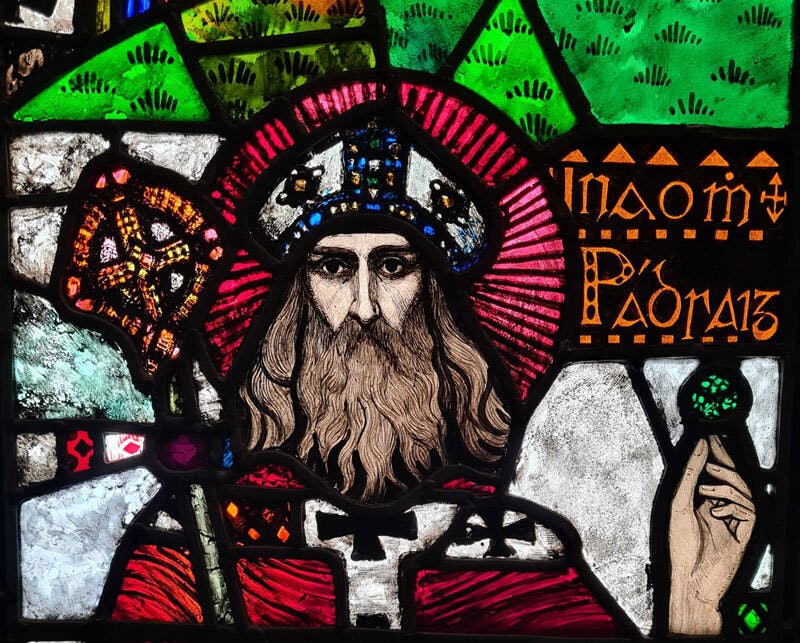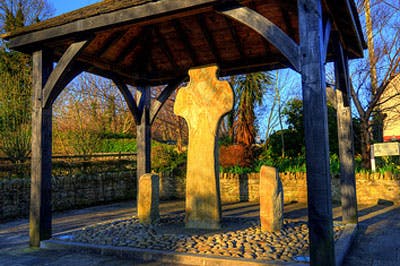

Wow, Victoria! Sounds like you are very in touch with your roots -- which is great! Thank you for reading and taking the time to write in. We appreciate it!
Written by Ciaran Vipond on Feb 15, 2023 | 6 Comments
The patron saint of Ireland but not Irish, a holy man that was ready for battle and was liable to shape-shift? In St. Patrick's own words, his story is "a long story – to tell each and every deed of mine, or even parts of it" we've had to "make it short." So where to begin to answer the question “Who was St. Patrick?”
Starting at the beginning, many may be surprised to find that the most famous patron saint of Ireland was not actually Irish. Born in the 4th century in Roman Britain, Patrick was raised in a Christian household, the son of Calpornius, a deacon. He was captured by Irish pirates and brought to Ireland as a 16-year-old.
Sold into slavery, the teenage Patrick was set to work shepherding sheep in Ireland. In his own writings, Patrick recounts that he found deep faith on the cold and lonely slopes of the beautiful Irish countryside - "in one day I would pray up to one hundred times, and at night perhaps the same."

He escaped his captors six years later after hearing a call telling him to leave Ireland. He managed to make it to the coast, hitching a ride with pagan sailors back to Britain where he joyfully reunited with his family.
Shortly after he returned home to Britain and his family, the now twenty-two-year-old Patrick had a vision calling him to serve his faith. Believing it to be a message from God, he resolved to return to Ireland and convert the pagan Irish to Christianity.
Driven by his faith, he trained to be a priest in Auxerre in France, took the name we know him by today, Patrick or the Latin Patricius, and returned to Ireland to convert the pagans to his Christian faith. Patrick's belief in his calling was strong. Having been captive in Ireland for six years, he knew that his life would be threatened.
There are many legends about what happened to Patrick on his first return to Ireland. One says Patrick met a powerful King, who promptly tried to kill him. Patrick was able not only to survive but convert the ruler and go on to preach the Gospel throughout Ireland.

In his many years in Ireland, St. Patrick was said to have baptized over 120,000 Irish people, established over 300 churches and monasteries, becoming bishop of all Ireland. He is credited with firmly rooting Christianity on the island if not introducing it first. As an Irish speaker, he was able to relate to people across the island, merging Irish and pagan symbols with Christian ones.

The story of how he used shamrock to illustrate the concept of the Holy Trinity resulted in this small plant becoming not only a symbol of St. Patrick or his feast day, but Ireland itself, worn by people worldwide.
Yet another story attributes the creation of the iconic Celtic Cross to St. Patrick. He was known for merging Christian and Celtic imagery and Patrick was apparently keen to incorporate the Celtic Sun and shield motifs in the Christian cross, making it more palatable to his would-be converts.
The origins of this story are not clear. And the oldest stone crosses in Ireland come well after the time of Patrick.

One of the oldest is the Donagh Cross in Donegal, also known as the St. Patrick Cross. A monastery was reportedly founded here in the 5th century by his disciple or even Saint Patrick himself. Perhaps this might have helped the story of "St. Patrick's Cross" gain weight.
There is much we don’t know about the life of Patrick. But for what we do know, we can largely thank the saint himself. His largely autobiographical Confessio and his letter the epistola, are some of the very oldest texts written in any language on the island of Ireland that survived to this day. A copy can be found in the famous 9th Century Book of Armagh, housed in Trinity College Dublin.
Many will know the story of St. Patrick driving the snakes out of Ireland but there are many more tales and legends about the saint, with more than a sprinkling of fantastical Celtic mythology.
There are stories of him transforming into a deer to avoid ambush, his crozier transforming into an ash tree, and lighting bonfires that could not be put out in defiance of an Irish High King. Storytellers near Lough Derg Co. Donegal may regale you with the story of how St. Patrick trapped a hideous wounded monster at the bottom of the lake where it lurks to this day, turning the lake waters red with its blood.
Patrick himself wrote that he raised some 33 people from the dead to recount the wonders of heaven or the horrors of hell to his would-be converts.
For centuries St. Patrick’s day was a holy day marking the Saint’s death on March 17th. Patrick is widely believed to be buried on the Hill of Down in Downpatrick. A stone marking this spot was put in place in 1901 and the site is now a popular spot to visit.
But for all the recognition and stories of his great work, St. Patrick was never actually canonized, making his saintly status somewhat shaky. But St. Patrick isn’t the only saint to skip this technicality, as there was no formal canonization process in the early days of the Catholic Church.
Saints from this period made the grade by being martyred for the cause, or like Patrick, for being viewed as spectacularly holy.
Luke Wadding, a 17th-century Franciscan priest cemented St. Patrick's status in the Catholic church with a successful campaign to add his feast day to the official Christian calendar. Before the 17th century, St. Patrick's Day was intermittently observed, even in Ireland. Today thanks to the work of Luke Wadding and all that came after him, St. Patrick's feast day is a global celebration unlike any other.
Which leaves us with the icon many know today. A symbol of Ireland and of faith recognized worldwide. And though he may not have been born on the island, we will certainly claim him and are very happy to share our patron saint with the world each March 17th.
Have a question or something you're not entirely sure about when browsing our pieces? Please reach out. You can send us a note or give us a call—the Dublin workshop is here to make sure that you have a perfect experience from start to finish with My Irish Jeweler.
Follow us on Facebook and Instagram, to see what's new and upcoming. Join our Email list for early offers and special features.

Ciaran Vipond
My Irish Jeweler
Born in Co. Antrim and reared in Dublin, I was fascinated with Gaelic culture from an early age. I suppose it's not surprising given my mother inherited a grá for the Irish language from my grandfather, an Irish school headmaster. And that grá continues! My brother and sister are now Gaelic teachers here in Ireland, my niece is an award winning Irish dancer, and I proudly work to share Irish culture through our Irish and Celtic Jewelry at My Irish Jeweler!
I love researching and reading about the history of Irish design. It's at the core of what we do here at My Irish Jeweler. I find much of it so interesting that I have to share what I find. I hope you enjoy it!


Wow, Victoria! Sounds like you are very in touch with your roots -- which is great! Thank you for reading and taking the time to write in. We appreciate it!

Love it

Thanks for reading, David! Pleased that you enjoyed the piece.

Thank you so much for sharing this information! I always thought St. Patrick was Italian.

Our pleasure, Emily! We're always glad to use our famous Irish "gift of the gab" when it comes to St. Patrick. Truly an interesting and many-layered story and figure.

Raised by my irish mother and Welsh father a good compilation